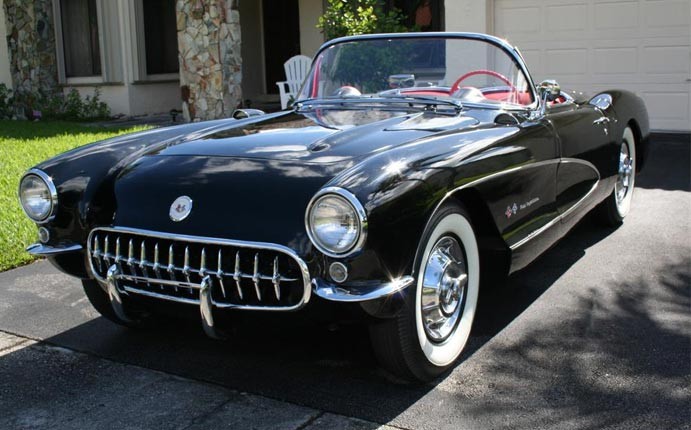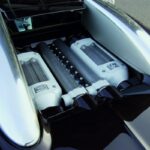The 1950s were a transformative decade for the Chevrolet Corvette, solidifying its place in automotive history as “America’s Sports Car.” While the early years presented challenges and adjustments, the decade culminated in a model that perfectly encapsulated the Corvette’s promise: the 1957 Corvette. Amongst its 1950s brethren, the 1957 stands out as the pinnacle of innovation and performance, setting the stage for Corvette’s enduring legacy.
The Rise of the 1950s Corvette: Early Challenges and Evolution
The Corvette’s debut in 1953 marked Chevrolet’s bold entry into the sports car market. However, the initial models faced criticism and slow sales. The first generation, often referred to as the C1, underwent continuous refinement throughout the 1950s. Early Corvettes were equipped with an inline-six engine, but the introduction of the V8 engine in 1955 was a crucial turning point, injecting much-needed power and performance into the platform. This evolution was essential for the Corvette to truly compete and capture the hearts of American car enthusiasts. Each year brought improvements in styling, performance, and features, building towards the landmark 1957 model.
1957 Corvette: The Game Changer
The 1957 Corvette represented a significant leap forward and is often considered the quintessential 1950s Corvette. It was in this year that Corvette truly came into its own, delivering on the promise of world-class performance and captivating design. Several key enhancements contributed to its iconic status.
Engine Revolution: The 283 Cubic Inch V8
Under the hood, the 1957 Corvette boasted a larger and more potent 283 cubic inch V8 engine, an evolution of the previous 265 cubic inch version. This engine, most notably in its fuel-injected form, achieved a groundbreaking milestone: producing one horsepower per cubic inch. This “one horsepower per cubic inch” benchmark was a remarkable feat of engineering at the time and highlighted the technological advancements of the 1950s Corvette. The fuel-injected “Fuelie” engine delivered exhilarating performance and solidified the Corvette’s reputation as a serious performance machine.
Performance Enhancements: Transmission and Suspension
Beyond the engine, the 1957 model introduced further performance-oriented options. For the first time, a four-speed manual transmission became available, offering drivers enhanced control and engagement. Additionally, Zora Arkus-Duntov, a key figure in Corvette’s development, introduced the “racing special” heavy-duty suspension package. This package included upgraded springs, shocks, anti-sway bar, and other components designed to optimize handling and performance, particularly for those interested in pushing their Corvettes on the track. Although these performance options were not widely adopted due to cost and perhaps a lack of awareness, they signaled Corvette’s serious intentions in the realm of high-performance sports cars.
Racing Prowess: Sebring Victory
The performance of the 1957 Corvette wasn’t just theoretical; it was emphatically demonstrated on the racetrack. At the Sebring endurance race, before the AMA racing ban, two production model 1957 Corvettes achieved a stunning GT class victory, outperforming even the Mercedes-Benz 300SL, previously considered one of the world’s fastest cars. This racing success was crucial in establishing the Corvette’s credibility as a world-class sports car and further cemented its iconic status.
The 1950s Corvette Legacy: Impact and Influence
Despite facing sales challenges against Ford’s Thunderbird in the mid-1950s, the Corvette’s superior track performance and evolving design began to resonate with enthusiasts. The 1957 Corvette played a significant role in Ford’s decision to discontinue the two-seater Thunderbird after 1957, effectively conceding the pure sports car market to Chevrolet. While the Thunderbird transitioned to a more commercially successful 2+2 layout, the Corvette remained dedicated to its sports car roots, a decision validated by its increasing popularity and enduring appeal. The advancements made throughout the 1950s, especially culminating in the 1957 model, laid the foundation for the Corvette to become a true American icon.
In conclusion, while the Corvette debuted in 1953 and incorporated the V8 engine in 1955, the 1957 Corvette was the first model to truly embody everything that defines “America’s Sports Car.” It offered a compelling combination of groundbreaking performance technology, stunning 1950s aesthetics, and a price point that, while aspirational, remained within reach for many. The 1957 Corvette not only represented the pinnacle of 1950s Corvette engineering but also played a pivotal role in shaping the Corvette’s identity and securing its long-term success. For these reasons, the 1957 Corvette rightfully earns its place as the best of the 1950s Corvettes, a true symbol of American automotive excellence.

